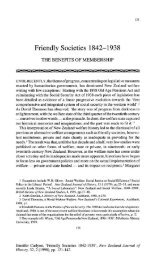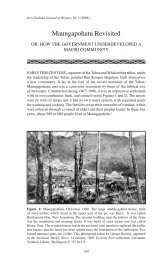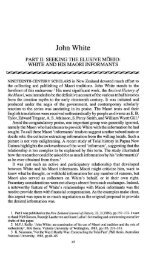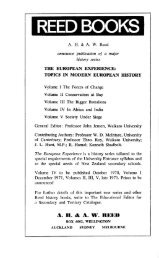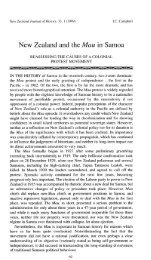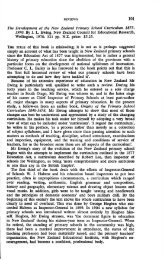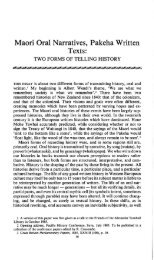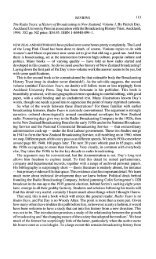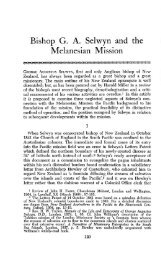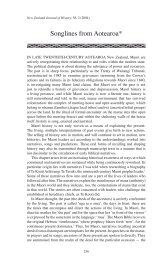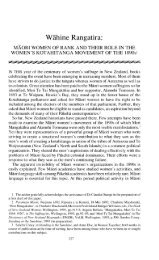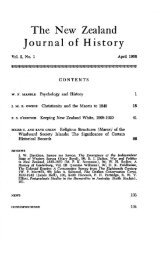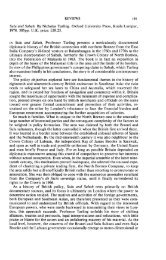Irish Migration to the West Coast, 1864-1900 - New Zealand Journal ...
Irish Migration to the West Coast, 1864-1900 - New Zealand Journal ...
Irish Migration to the West Coast, 1864-1900 - New Zealand Journal ...
Create successful ePaper yourself
Turn your PDF publications into a flip-book with our unique Google optimized e-Paper software.
LYNDON FRASER<br />
based around <strong>the</strong> north-east Ulster counties of Antrim, Down and Deny — an<br />
area which had strong connections with <strong>the</strong> provinces of Canterbury and Otago.<br />
The existence of chain migration among <strong>the</strong> <strong>West</strong> <strong>Coast</strong>'s expatriate population<br />
ensured <strong>the</strong> predominance of <strong>the</strong>se originating localities remained constant<br />
throughout <strong>the</strong> period under consideration. Whatever <strong>the</strong>ir origins, an<br />
overwhelming majority of newcomers emanated from a rural, small-farming<br />
environment in Ireland. They were considerably older than <strong>the</strong>ir compatriots<br />
arriving in <strong>the</strong> great emigration ports of Liverpool, <strong>New</strong> York, or Sydney and<br />
<strong>the</strong>y possessed markedly different levels of experience acquired during an<br />
extended colonial apprenticeship. By <strong>Irish</strong> standards, <strong>the</strong>se expatriates were<br />
multi-skilled and extremely resourceful. Most had procured experience through<br />
prolonged exposure <strong>to</strong> Australia's labour market, and this learning served as<br />
preparation for <strong>the</strong> hardships of everyday life on <strong>the</strong> <strong>West</strong> <strong>Coast</strong>.<br />
The composite profile of <strong>Irish</strong> migration <strong>to</strong> <strong>the</strong> region closely resembled<br />
Australian patterns in terms of religious affiliation, socio-economic status and<br />
proportional representation. Like <strong>the</strong>ir counterparts in south-western <strong>New</strong> South<br />
Wales, for example, <strong>the</strong>se newcomers encountered an environment where<br />
intergroup relations were structured by an ethos of cosmopolitanism and <strong>the</strong><br />
absence of entrenched power bases. 94 The <strong>Irish</strong>-born were a numerically strong<br />
charter group, whose members actively participated in <strong>the</strong> process of colonization<br />
and in <strong>the</strong> formation of local community life. But it is true that <strong>the</strong> <strong>West</strong> <strong>Coast</strong>'s<br />
<strong>Irish</strong> intake differed from <strong>the</strong> conesponding movement <strong>to</strong> eastern Australia in<br />
several respects. The preponderance of single males, <strong>the</strong> disproportionate number<br />
of married women and <strong>the</strong> dominance of privately financed immigration among<br />
<strong>the</strong> region's expatriates reflected diverging trajec<strong>to</strong>ries of economic development<br />
in each destination. Yet <strong>the</strong> crucial function of Old World social ties in influencing<br />
migration <strong>to</strong> <strong>the</strong> <strong>West</strong> <strong>Coast</strong> suggests underlying similarities with Australian<br />
patterns of settlement and adjustment. In practical terms, <strong>the</strong> selective re-creation<br />
of kinship and neighbourhood networks provided an important source of<br />
companionship, material assistance and information for recent arrivals on <strong>the</strong><br />
goldfields. On ano<strong>the</strong>r level, however, <strong>the</strong> persistence of <strong>the</strong>se connections<br />
offered a pragmatic solution <strong>to</strong> <strong>the</strong> consequences of dispersion by preserving<br />
notions of familial duty prescribed by <strong>Irish</strong> society. Distance may have strained<br />
or even broken allegiances anchored in Ireland — as <strong>the</strong> Mitchell conespondence<br />
shows — but <strong>the</strong> evidence seems <strong>to</strong> indicate that migrants constructed complex<br />
webs of association, which extended across <strong>the</strong> Tasman in both directions and<br />
stretched as far as distant rural households in <strong>the</strong> Bunen of Clare. Although this<br />
conclusion must remain provisional, <strong>the</strong> close links of mobility and kinship<br />
that tied <strong>the</strong> <strong>West</strong> <strong>Coast</strong> <strong>Irish</strong> <strong>to</strong> <strong>the</strong> colonies of Vic<strong>to</strong>ria and <strong>New</strong> South Wales<br />
suggest that <strong>the</strong>ir experiences also need <strong>to</strong> be incorporated in<strong>to</strong> <strong>the</strong> nanatives of<br />
<strong>Irish</strong>-Australian his<strong>to</strong>ry.<br />
University of Canterbury<br />
LYNDON FRASER<br />
220



